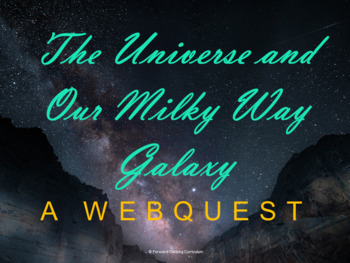The Universe and Our Milky Way Galaxy Webquest (Astronomy and Space Science)
- Zip
- Internet Activities
- Webquests
What educators are saying
Also included in
- Reach students in the classroom or at home with this set of twenty earth science webquests. Every earth science webquest in the set comes with a clickable webquest file, a worksheet, and an answer key. Each webquest link points to information that your students need to complete the worksheet. This EPrice $67.90Original Price $135.80Save $67.90
Description
The Universe and Our Milky Way Galaxy Webquest comes with a worksheet and an answer key. Each clickable link in the webquest points to information that your students need to complete the worksheet. Besides sharing the webquest with students and printing the worksheets, no other prep is needed to conduct this astronomy and space science lesson on the universe, galaxies, and the Milky Way.
How to use this resource:
1.) Share the PDF webquest file with clickable links to student computers.
2.) Print the accompanying worksheets.
3.) That’s it! Students are ready to get started.
Students click the links embedded into stunning photographs in the webquest to find answers to questions on various web pages. (The questions follow the order of the links.) Students write their responses on the accompanying worksheet.
The universe, galaxies, and the Milky Way are fundamental topics in an astronomy and space science curriculum. In this webquest, students will be introduced to the following relevant cosmology and astronomy concepts and vocabulary:
• Evidence for the Big Bang: red shift, cosmic background radiation
• Composition of the universe: chemical elements, dark energy, dark matter
• Possible ways the universe can end: a big chill, big crunch, or big rip
• Galaxy groups (such as our Local Group) and clusters
• Features of galaxies: composition, active galactic nuclei (AGN), and black holes
• Features of the Milky Way: its spiral arrangement and center bulge, the increased star density near its core, and the black hole Sagittarius A*
All Forward-Thinking Curriculum webquests meet the following stringent quality criteria:
· All links connect to very carefully-selected and modern websites.
· All linked online texts are from highly authoritative and reputable sources (specific sources for this webquest are shown below).
· Students can complete all of the included questions by accessing the online texts and the images alone. No earphones or other special technology are needed to access the information.
· The online texts are at a reading level that is accessible to middle and high school students.
· Very importantly, all links are routinely checked and maintained!
This resource includes the following:
• Webquest: Stunning images directly link students to relevant informational text from the European Southern Observatory’s Supernova Planetarium, the National Schools’ Observatory, the BBC, and NASA’s James Webb Space Telescope team. Click the green preview button above to preview every page. (PDF, 8 pages)
• Student worksheet (PDF, 17 short-answer questions, 4 pages)
• Answer key to student worksheet (PDF, 4 pages)
You can enjoy this and the rest of the webquest set at a fraction of the price. Click any link below for previews:
Space Science Topics:
· The Universe and Our Milky Way Galaxy
· Planets and Space Rocks in the Solar System
Atmospheric Science Topics:
· Tornadoes, Thunderstorms, and Hurricanes
· Air Masses, Fronts, Weather, and Precipitation
Geology Topics:
· Weathering, Erosion, and Deposition
Hydrology Topics:
· Watersheds, Rivers, and Lakes
Please remember, this purchase is for the use of one teacher. It is not intended to be shared. Please use the “Buy Licenses to Share” button if more than one teacher will be using it. Thank you!
© Forward-Thinking Curriculum






